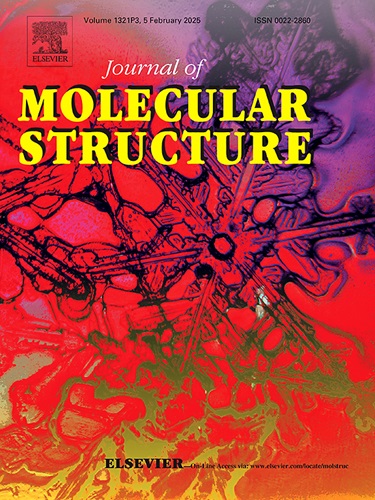Remote substituents effect on the valence and magnetic behavior in mononuclear cobalt complexes
IF 4
2区 化学
Q2 CHEMISTRY, PHYSICAL
引用次数: 0
Abstract
Four Co(Ⅱ/Ⅲ) mononuclear complexes [CoⅢ(H2L1)](NO3)·H2O (1), [CoⅢ(H2L2)](NO3) (2), [CoII(H2L3)] (3), [CoII(H2L4)] (4) (H2L = N,N’-bis(2‑hydroxy-5-methylbenzyl)-1,4-bis(3-iminopropyl)-piperazine, H2L2 = N,N’-bis[(2-hydroxybenzilideneamino)-propyl]-piperazine, H2L3 = N,N’-bis(2‑hydroxy-5-bromobenzyl)-1,4-bis(3-iminopropyl)-piperazine, H2L4 = N,N’-bis(2‑hydroxy-5-nitrobenzyl)-1,4-bis(3-iminopropyl)-piperazine) based on hexadentate Schiff base ligands were synthesized and charactered. Influenced by the electron-donating Me and H groups, the paramagnetic Co(II) ions in 1 and 2 become diamagnetic Co(Ⅲ) ions, forming a six-coordinate octahedral coordination geometry. For complexes 3 and 4, the Co(Ⅱ) ions remain the same because of the electron-withdrawing Br and NO2 groups, forming a trigonal prismatic coordination geometry. Magnetic studies show that 3 is a field-induced SMM and 4 is a zero field SMM, which proves that the remote substituents have an important effect on the oxidation states of cobalt ion and the magnetic properties of the system. Ab initio calculations indicate that complexes 3 and 4 possess similar axial magnetic anisotropy parameters. However, complex 3 represents much stronger rhombicity, which can be ignored in 4. Moreover, the transition magnetic moment within the ground KD of 3 is much higher for 3 compared to 4, suggesting more significant QTM process in 3, which is consistent with no peaks in ac susceptibility measurement under zero dc magnetic field. For complex 4, when the intermolecular antiferromagnetic exchange was considered through the mean-field approximation, the better agreement between calculated and experimental plots were obtained. This result further proves their existing significant magnetic anisotropy and the reliability of these parameters.
远端取代基对单核钴配合物价态和磁性的影响
合成了四种Co(Ⅱ/Ⅲ)单核配合物[CoⅢ(H2L1)](NO3)·H2O (1), [CoⅢ(H2L2)](NO3) (2), [CoII(H2L3)] (3), [CoII(H2L3)] (4) (H2L = N,N ' -双(2-羟基-5-甲基苄基)-1,4-双(3-亚氨基丙基)-哌嗪,H2L3 = N,N ' -双(2-羟基-5-溴苄基)-1,4-双(3-亚氨基丙基)-哌嗪,H2L4 = N,N ' -双(2-羟基-5-硝基苄基)-1,4-双(3-亚氨基丙基)-哌嗪)基于六齿状希夫碱配体并对其进行了表征。受给电子基团Me和H的影响,1和2中的顺磁性Co(II)离子变成反磁性Co(Ⅲ)离子,形成六坐标八面体配位几何。对于配合物3和4,Co(Ⅱ)离子由于具有吸电子性的Br和NO2基团而保持不变,形成了三角棱柱配位几何。磁性研究表明,3是场致SMM, 4是零场SMM,这证明了远端取代基对钴离子的氧化态和体系的磁性有重要影响。从头计算表明,配合物3和4具有相似的轴向磁各向异性参数。而配合物3具有更强的菱形性,在4中可以忽略。3的地KD内的过渡磁矩比4大得多,说明3的QTM过程更显著,这与零直流磁场下交流磁化率测量无峰一致。对于配合物4,当采用平均场近似考虑分子间反铁磁交换时,计算结果与实验结果吻合较好。这一结果进一步证明了它们存在显著的磁各向异性和这些参数的可靠性。
本文章由计算机程序翻译,如有差异,请以英文原文为准。
求助全文
约1分钟内获得全文
求助全文
来源期刊

Journal of Molecular Structure
化学-物理化学
CiteScore
7.10
自引率
15.80%
发文量
2384
审稿时长
45 days
期刊介绍:
The Journal of Molecular Structure is dedicated to the publication of full-length articles and review papers, providing important new structural information on all types of chemical species including:
• Stable and unstable molecules in all types of environments (vapour, molecular beam, liquid, solution, liquid crystal, solid state, matrix-isolated, surface-absorbed etc.)
• Chemical intermediates
• Molecules in excited states
• Biological molecules
• Polymers.
The methods used may include any combination of spectroscopic and non-spectroscopic techniques, for example:
• Infrared spectroscopy (mid, far, near)
• Raman spectroscopy and non-linear Raman methods (CARS, etc.)
• Electronic absorption spectroscopy
• Optical rotatory dispersion and circular dichroism
• Fluorescence and phosphorescence techniques
• Electron spectroscopies (PES, XPS), EXAFS, etc.
• Microwave spectroscopy
• Electron diffraction
• NMR and ESR spectroscopies
• Mössbauer spectroscopy
• X-ray crystallography
• Charge Density Analyses
• Computational Studies (supplementing experimental methods)
We encourage publications combining theoretical and experimental approaches. The structural insights gained by the studies should be correlated with the properties, activity and/ or reactivity of the molecule under investigation and the relevance of this molecule and its implications should be discussed.
 求助内容:
求助内容: 应助结果提醒方式:
应助结果提醒方式:


